
Ulrike Reinhard is The Nomad 🙂
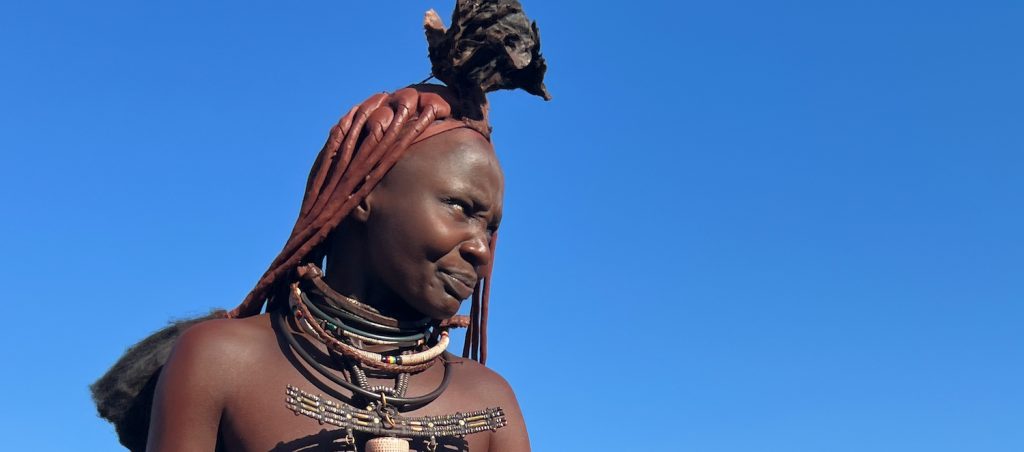
An Omuhimba woman, I met her on my way to Epupa Falls
A few “scientific” remarks on the term “indigenous” to start with.
Around 5,000 indigenous peoples live in about 90 countries around the world, with a total of more than 476 million people. They make up about six per cent of the world’s population – but 19 per cent of the people living in poverty. And they speak 4000 different indigenous languages, many of them are threatened. A language is considered endangered when there is a tendency that it is no longer passed on as a mother tongue to subsequent generations and thus dies out..
What does indigenous mean? The UNO and others have characterized indigenous as follows:
- relatively first use/settlement of a territory;
- voluntary preservation of cultural distinctiveness (vis-à-vis the majority population), especially in terms of language, modes of production, social organisation, institutions, religion and spiritual values;
- self-identification and recognition by others as a distinct community;
- experience of dispossession, exclusion, marginalisation, oppression or discrimination (where these conditions may or may not persist).
In late February, early March of 2023 I visited a Himba family in the proximity of Epupa Falls, at Cunene River. A friend of a friend, who is Himba but walked away from their traditional way of living, brought me there. I wanted to “feel” their way of living. I am fully aware that in a short visit you only scratch at the surface, still I feel it’s better than an organised bus tour to one of the showcased villages which you can easily find – at least for me.
The Himba are indigenous people. They are semi nomadic and live in the northern part of Namibia and strech into the south of Angola. There are approximately 50.000 of them. Many still live their traditional lives and reject most forms of modernism. Others live in two worlds – which of course is creating problems. This would be another story though. Maybe I’ll write about this later.
I had seen many Himba in Opuwo, a small buzzling very vibrant town in northern Namibia where many tribes live side by side, very often wearing their traditional clothes. It’s a colourful town, very different from other towns in Namibia. I’d say it is a very African town. It is a bit off the regular tourist track; you will find a couple of average guest houses in Opuwo and one lodge, up on the hill, overlooking the Kaokoland where the tourists “meet”. I stayed there as well when I was in town and I was shocked when I heard what some tourists were saying. One older German couple who had seen me from their car in town, told me, that they are scared to leave the car in town and go into the supermarket. They needed water but didn’t dare to enter the market – because there were “only” black people.
The next morning I went down with them, asked them to park the car right in front of the supermarket and lock it and come with me into the shop. They were scared but followed me. Once they entered they said: “Ohh, they have everything here! It is clean! And the people are so friendly and helpful!” Interesting, I thought. We loaded the water into the trunk of the car and I asked them to walk around with me. “But the car!”, they said, “will it be safe?” I said: “Yes, I think so! These are not bad people. They just have a different skin colour and have much less than you! That’s all!”
We walked around for 30 minutes, went through the open market and a shopping mall. Then we drove back to the hotel. I felt happy that they went with me, got what they wanted and felt at least a little bit safer. For the afternoon the couple had booked a bus tour to a Himba village close by. They invited me to join. I rejected – I hate it when a bus enters a village, 20 white people get out, the villagers perform their dances and songs and then guide the white invaders to their market stalls to buy jewelry and other kind of “souvenirs”.
From what I’ve heard, the villagers need to pay back the bus companies/hotels 80% of their turnover! What a scam! And what a fake experience! The same with the Masai villages in Kenya. It horrifies me. Yet, these people felt safe and thought it is a great experience. Fine. Just not my cup of tea.
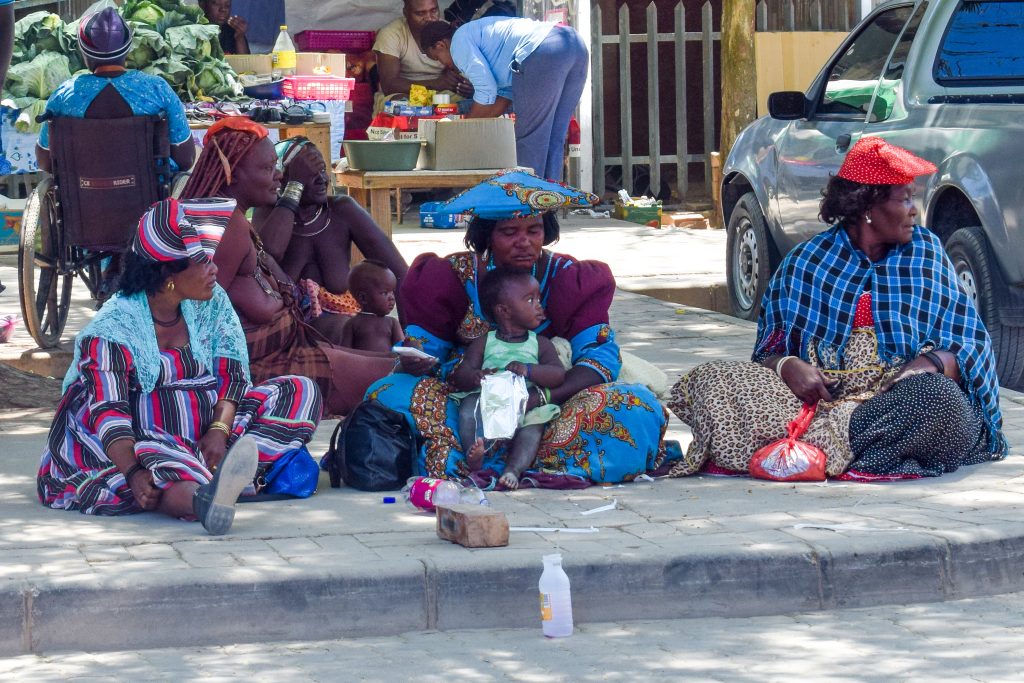
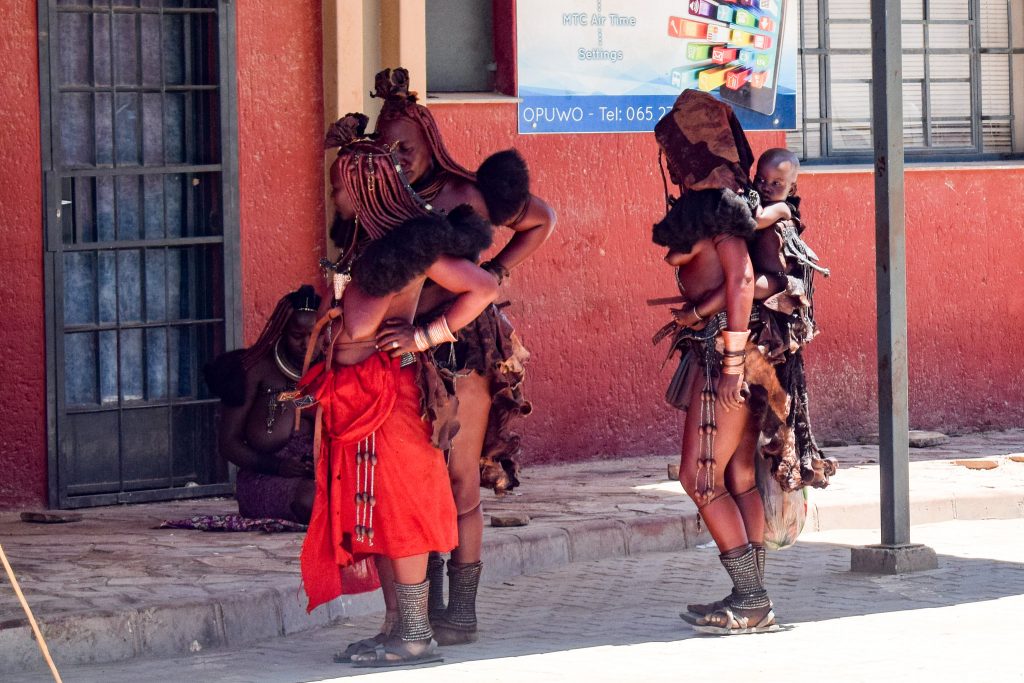
Hereros und Himba in the streets of Opuwo
I had other plans.
I would take a local taxi going from Opuwo to Epupa Falls and there I hoped to see and visit Himbas in a more undisturbed environment – guided by the Himba friend of a friend. And that’s what I did. The circumstances were a bit “weird” becaus ethis friend had a terrible hang over when we met. He assured me a few times he was fine, but his eyes were red and swollen and you could smell the alcohol. Yet we left Epupa Falls at 7.30 am and walked for almost two hours up and down the hills along the Cunene River. The small family he brought me to was currently staying at the foothill of a little mountain, not far from the river.
When we reached, the “friend” just lied down in the shadow of a tree and fell asleep – no further introduction besides a quick “good morning”. I felt very displaced and uncomfortable. There was the father and two young men, and then there were the women with the children. Their area was fenced, because of the cattle. They had built five mud “caves” – I can’t call it hut or house – in which they sleep.
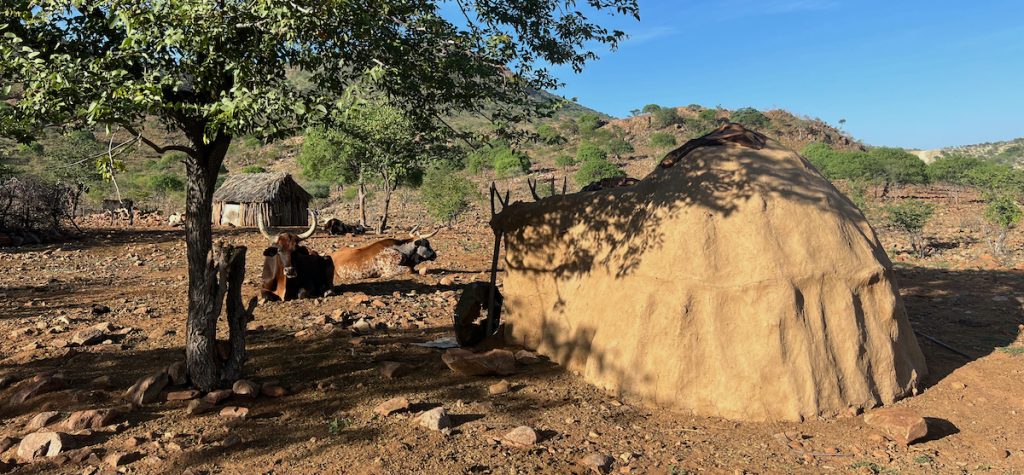
One of the mud caves
I sat down right next to the “friend” and waited. The Himbas continued with their daily routines and didn’t bother about us. It was already boiling hot by the time we arrived. I gave my guide some time to sleep and just watched what was going on around me. I didn’t move. After a while his phone rang and he woke up. Lucky me – that was the time when the conversation started. I wanted to ask a few questions to the family.
The family has been here for the last six weeks and they will stay as long as their goats and cows find food. It was rainy season so they stay longer as usual, but the rains weren’t really good so far – they were hoping for more. When ever they leave a place they only take their belongings such as pots and tools. Sometimes they return after a year or so to the same place – then they will use the same caves, fences, fireplace, stalls again.
Their day begins with sunrise. By the time we arrived the young men were milking the cows and goats. The family owned quite some live stock, the head of the family said the cattle is passed on over generations. Cows, goats and people were staying all together.
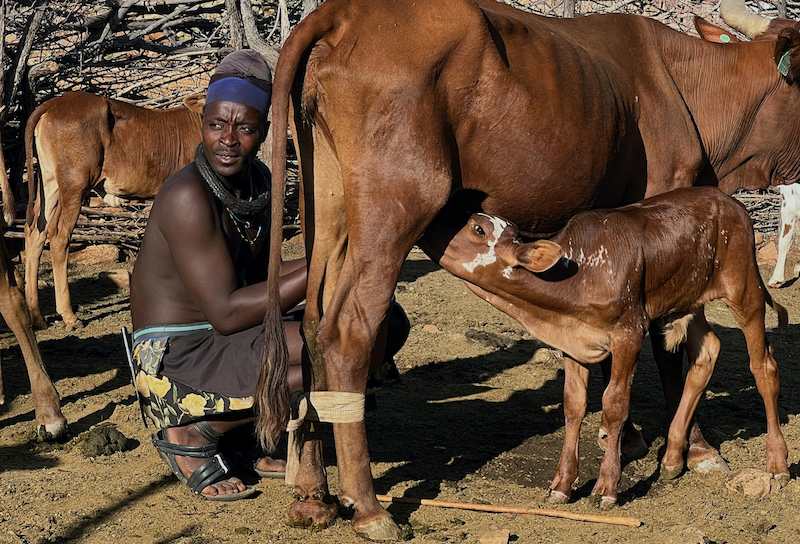
I was fascinated by their beautiful and healthy bodies – the young man who was melking the cows and also the head of the family, a very proud father who loves to be surrounded by his youngest children. I was wondering why they are so healthy because vegetables and fruits are very rare on their menue list. They mainly live from milk in various forms, their caddle and fish. Vegetables don’t grow in this climate.
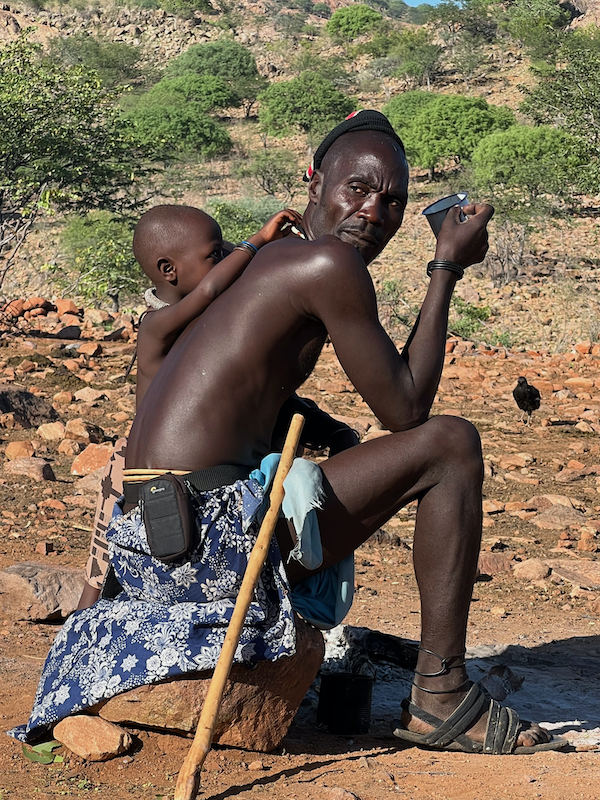
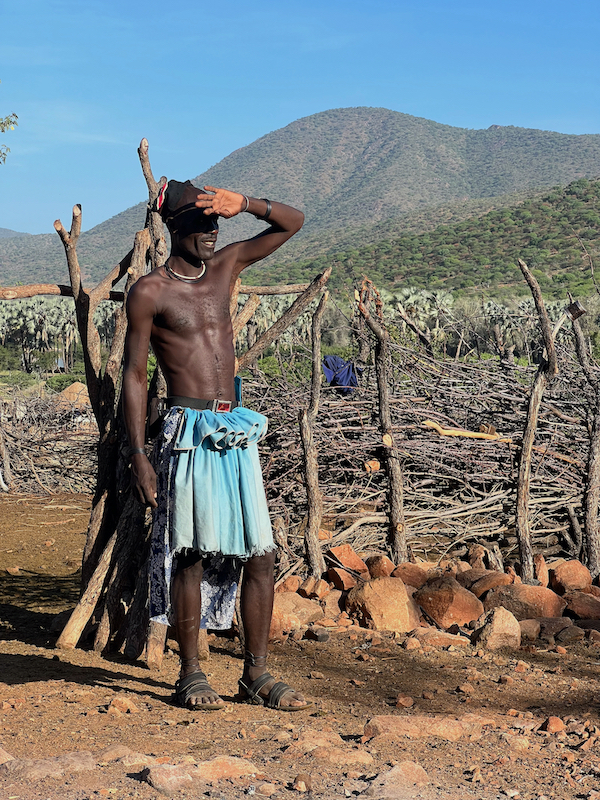

Hierarchy is important in the HImba tradition and there wasn’t any doubt that he was the respected head. In their little hamlet of 5 “caves” he lived with his wives – I couldn’t figure out if he had three or four wives – and children. His oldest son (photo above) was already married and his wife has joined the family here. He was eplaining why he keeps his tradition alive, he feels close to nature, to the rivers and land which is feeding his caddle. He is aware of mordernism and what he sees when he goes into the next bigger town which is roughly 100 km from his current place is not really encouraging. He sees a lot of poverty and its many side effects, so he refuses to become part of it. Yet one of his daughters is going to school in a nearby village. It seems to be some kind of a test for him – how can a life at school be combined with his traditional way of living. The problems starts with the clothes. At the government school the Himbas are not allowed to come in their traditional outfits – they are forced to wear western clothes. So the girl who is going to school is dressed at home in western clothes – she is living in two worlds and obviously sometimes confused. Unfortunately the kind of education she is receiving in this close by village won’t garantee her a job – unemplyoment in Namibia is sky-rocketing and probably the teachers aren’t up to the top in the rural areas. Nor are the schools.
I’ve asked the father why he is sending her to school and his answer wasn’t pretty convincing: “Because many people do!” He doesn’t see any real value in it – yet he wants to give her a chance. Not knowing what the chances will be and also not knowing how confusing it will be for his child to be in these “two worlds”.

Medical supply and care is basically non-existent in this area – the next hospital is 100 km away. Even if it would be available the men prefer traditional ways of healing – let it be herbs, medicines from trees and roots or simply “old methods” of working with hot stones. The guys were treating a young boy with a hot stone, wrapped in a blanket. The young boy was suufering from stomach pain …

The women usually don’t leave their “village”, they are responsible for the children and all the homework. The men get the water, go fishing and go to the next town if flour or rice is needed. Some groceries are supported by the government. The women stay at home and work together. They clean their “caves” and wait in the morning until the cows and goats are melked. Then they cook the milk and make butter and prepare lunch. While they are shaking the milk in very special bowls hanging in front of their “caves”, they sit together and chat. The youngsters are part of these circles.
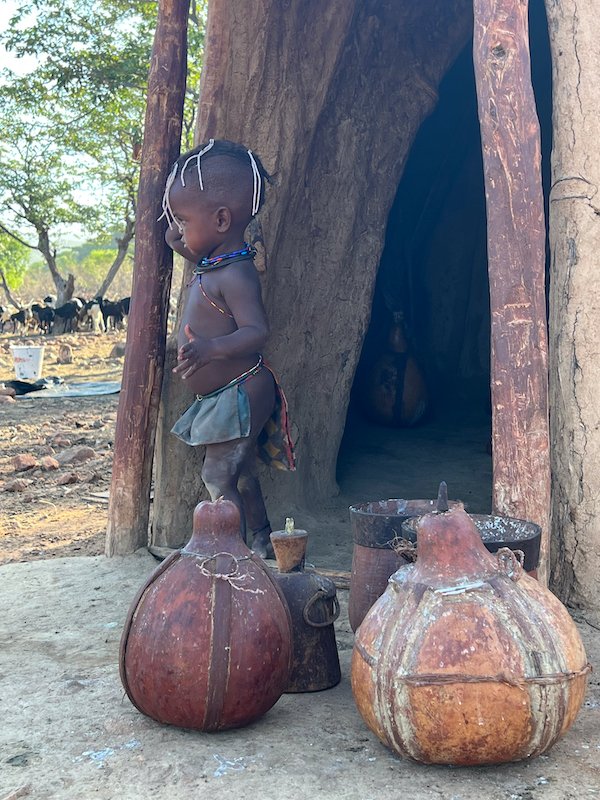
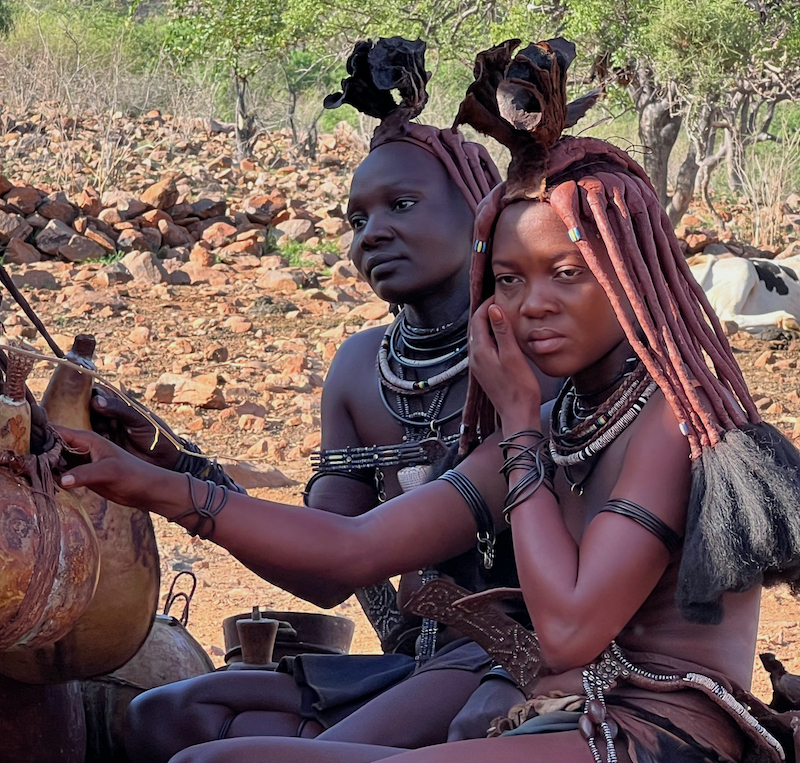
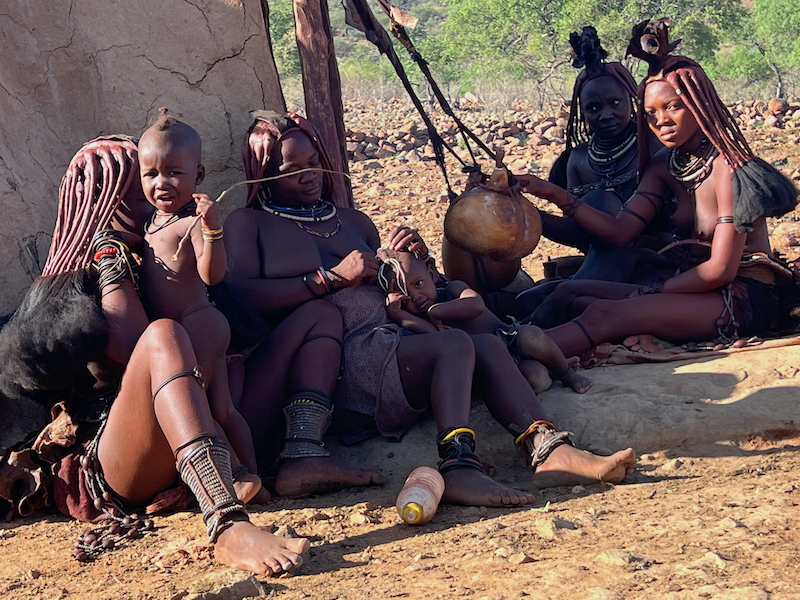
The women are very chatty among each other but hardly speak to anyone else. The husband explained to me that they never wash themselves with soap and water, they use a reddish paste made out of Ocre (an earthy usually red ore used as a pigment) with which they cream their bodies every morning. They use the same ingredients to make their hair – the tubes last for two to three month. They cream their bodies with devotion.
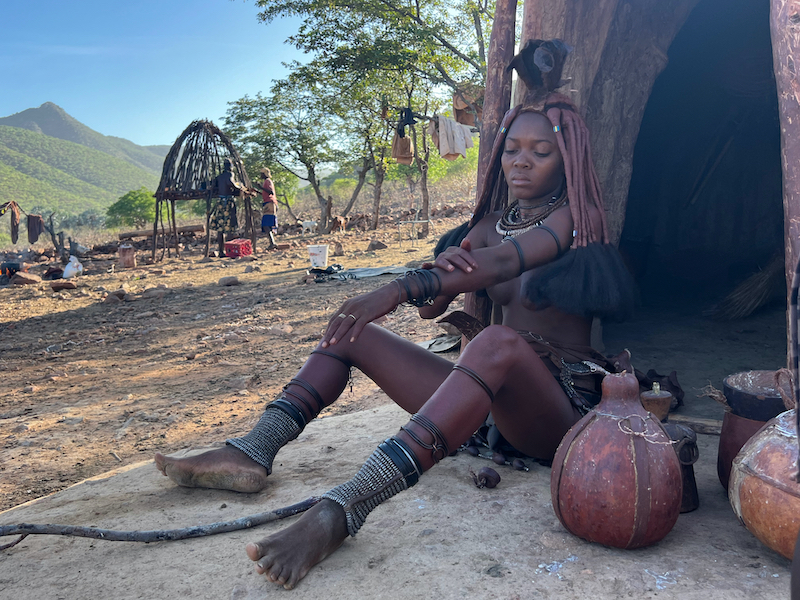
Some of the women especially the one in the photo above looked sad, I felt. There was an emptimess in her eyes. I only hope it wasn’t caused by my presence. It was a wierd situation, at least I felt like it. I wasn’t very comfortable but too curious not to stay.
I was a unique experience; we didn’t disturb their routines and they just went on with their lives. No sales pitches or money – it was just a visit. I appreciated their openess and appreciated their hospitality. For me their simple life with simple problems didn’t seem so “wrong” or “poor” – I wonder what they were wondering about me.